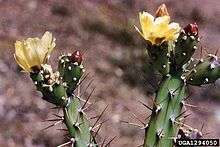Opuntia aurantiaca
| Opuntia aurantiaca | |
|---|---|
 | |
| Scientific classification | |
| Kingdom: | Plantae |
| (unranked): | Angiosperms |
| (unranked): | Eudicots |
| (unranked): | Core eudicots |
| Order: | Caryophyllales |
| Family: | Cactaceae |
| Genus: | Opuntia |
| Species: | O. aurantiaca |
| Binomial name | |
| Opuntia aurantiaca Lindl.[1] | |
Opuntia aurantiaca, commonly known as tiger-pear, jointed cactus or jointed prickly-pear, is a species of cactus from South America.[1] The species occurs naturally in Argentina, Paraguay and Uruguay and is considered an invasive species in Africa and Australia.[1]
It was declared a Weed of National Significance by the Australian Weeds Committee in April 2012, and was reported by the Committee to be the most troublesome of all cactus species in New South Wales and the worst Opuntia species in Queensland. It is currently controlled biologically in Australia using the cochineal insect Dactylopius austrinus, and to a lesser extent by the larvae of two moths, Cactoblastis cactorum and Tucumania tapiacola.
See also
References
- 1 2 3 "Opuntia aurantiaca (Haw.) Haw.". Germplasm Resources Information Network. United States Department of Agriculture. Retrieved 9 April 2011.
This article is issued from Wikipedia - version of the Friday, July 24, 2015. The text is available under the Creative Commons Attribution/Share Alike but additional terms may apply for the media files.